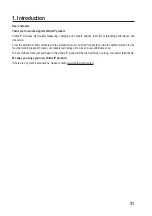
44
Follow the steps below to measure the pulse duration in %:
• Turn the DMM on and select the “%” measurement mode. “V
” will appear
on the display.
• Press the “MODE” button twice. “%” will appear on the display.
• Plug the red lead into the Hz terminal (K) and the black lead into the COM
terminal (I).
• Connect the two measuring probes to the object that you want to measure
(e.g. signal generator or circuit).
• The pulse duration of the positive half wave is shown as a percentage value on the display. For a symmetrical
signal, the pulse duration will be displayed as 50%.
• After taking a measurement, remove the leads from the measured object and switch off the DMM.
e) Measuring the temperature
When taking a temperature measurement, only allow the temperature probe to come into contact
with the surface of the measured object. The multimeter must not be exposed to temperatures
below or in excess of the operating temperature, as this may lead to incorrect measurements.
The temperature probe must only be used on voltage-free surfaces.
The multimeter features a wire sensor that can measure temperatures from -20 to +250 °C. To use the full tem-
perature range (-20 to +760 °C), purchase a Type-K thermal sensor. The measurement adapter that comes with the
multimeter is required to connect Type-K sensors with a miniature connector.
All K-type thermal sensors can be used for taking temperature measurements. The temperature can be displayed in
°C or °F.
Follow the steps below to measure the temperature:
• Turn on the DMM and select the “TEMP” measurement mode. “°C” will ap-
pear on the display.
• Use the “MODE” to change the temperature unit.
• Insert the temperature probe into the temperature measuring adapter in the
correct polarity. The thermocouple plug can only be inserted into the measure-
ment adapter in the correct polarity. Do not use force when inserting the plug.
• Insert the positive terminal on the measurement adapter into the tempera-
ture measurement socket (K) and the negative terminal into the COM meas-
urement socket (I).
• The temperature will appear on the display.
• “OL” indicates that the measurement range was exceeded or the sensor
was disconnected.
• After measuring, remove the sensor and turn off the multimeter.
If no temperature sensor is connected, the ambient temperature of
the DMM can be displayed using a jumper between the two meas-
urement sockets (“COM” and “Temp”). As the sensor is located
inside the housing, the display reacts very slowly to temperature
fluctuations. This function helps you check that the DMM is at the correct operating temperature after stor
-
age. An external sensor must be used for quick measurements.
Summary of Contents for 1693351
Page 114: ...114 ...
Page 115: ...115 ...
















































